#Operations and Maintenance in Facility Management
Explore tagged Tumblr posts
Text
Advanced Solutions For Water Treatment Plant Manufacturers in India
Water Treatment Plant Manufacturers in India incorporate cutting-edge technology and innovative processes to purify water and meet stringent quality standards. With this project, we have contributed to improving public health and ensuring a sustainable future for communities across India.

#Water Treatment Plant Manufacturers in India#Sewage Treatment Plant Manufacturers in India#Operation and Maintenance of Water Treatment#Operations and Maintenance in Facility Management#Water Treatment Plant Project#Sewage Treatment Plant Project#Effluent Treatment
2 notes
·
View notes
Text

Roles and responsibilities of Sydney strata specialists | Accord
Properties, whether residential or commercial, require regular cleaning and maintenance schedules to keep them looking spotless rather than dilapidated. With the top pick of strata specialists in Sydney, owners of residential or commercial properties will have their building management needs fulfilled.
Many people don’t have the time, resources, and expertise to clean or maintain their living spaces or manage the commercial properties they own. Fortunately, with a growing number of strata specialists in Sydney and nationwide, property owners can now enlist the services of these professionals.
Equipped with extensive knowledge and expertise in handling the various facets of strata management, Sydney strata specialists have the most up-to-date and sophisticated cleaning tools to keep the property value high, maximise health benefits, and raise people’s productivity.
Many people may not be aware of the roles and responsibilities of Sydney strata specialists, however, so this blog post will go on to highlight the duties that strata specialists in Sydney undertake to keep properties looking pristine and immaculate.
Through integrated, end-to-end services, the various roles and responsibilities that Sydney strata specialists take on can be monumental in keeping properties well-maintained. Among the obligations they take on pertaining to facilities management, are:
Inspecting properties and providing 24/7 customer support
Most residential and commercial properties have a designated strata owner that takes care of all strata-related matters within the premises, keeping facilities in working order and fixing any incongruity within short notice.
These round-the-clock services include maintenance management and building compliance, utility management services that cover resource optimisation, and reporting and metering.
Streamlining operations to minimise inconveniences
To keep facilities within a property functioning fully and looking spick and span, strata specialists work with due diligence and care by adhering to a prescribed maintenance, cleaning, and management schedule.
This helps properties, especially commercial properties, to avoid disruptions and inconvenience for fellow commercial space users.
Reducing the stress of dealing with multiple vendors
When it comes to strata specialists, they offer more than building management, cleaning, and maintenance. They are also the middlemen when negotiating complex contractual matters or deals with suppliers or multiple parties.
This offers a hassle-free and seamless experience in facilities management for owners of residential or commercial properties.
Maximising cost-efficiency
Strata specialists in Sydney have the credibility to inform property owners of the areas that don’t require cleaning and maintenance so they can reduce their strata management expenditure significantly and instead dedicate these funds to facilities that require these services.
Strata specialists also ensure that for the amount that’s spent on their services, they ensure the strata receive the maximum benefit—making the strata owner’s investment worth the buck.
Complying with existing and emerging regulations
To lessen the workload of property owners, strata can designate a building manager who can help conduct various tasks, such as attending general meetings, supervising contractors, performing general site inspections, and budgeting.
They can also ensure proper compliance with health and safety requirements in line with legislative laws. This includes up-to-date compliance with annual fire safety, contractors, and lift operations.
Ensuring strata value isn’t compromised or depreciated due to disrepair
When neglected or poorly maintained over a period of time, strata can experience wear and tear, deteriorate, and leave a bad impression on residents or commercial space users. It can even diminish their productivity and health.
With the help of top strata specialists who perform strata building management, strata owners can ensure their property looks immaculate and that the property value is not compromised due to disrepair or neglect.
Enlist the service of Sydney strata specialists to keep your strata property well-maintained for years to come
It is undeniable that strata specialists have helped many property owners manage the condition of their buildings so that they look pristine and fit for human habitation or commercial use. Their expertise can help minimise risks, reduce costs among property owners, and improve productivity and property value.
Schedule a consultation with Sydney’s leading provider of strata management, cleaning, and maintenance to keep your property in good shape and condition for many years to come.
#building management#facility management#cleaning services#Grounds and Garden Services#Maintenance Services#Operations Consulting#Property Related Services#and Integrated Maintenance#Property Management Services#Building Management Services Provider#Strata cleaning in Sydney#Commercial Cleaning Sydney#Strata building management#Building management
0 notes
Text
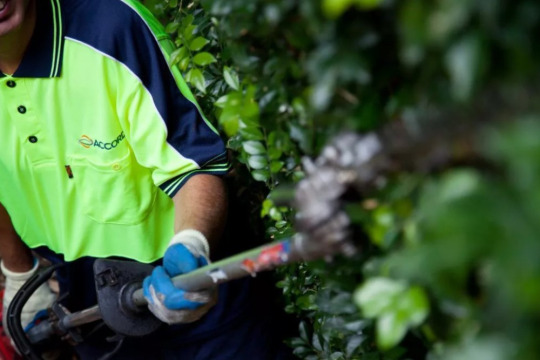
How a professional strata garden maintenance service can help you prepare for summer
Summer is the perfect time to spruce up your outdoor space, and a professional strata garden maintenance company can help you do just that.
Garden maintenance for strata properties focuses on mowing the lawn, trimming and pruning shrubs, and planting flowers and trees to keep your outdoor areas looking the best they have. With the weather getting warmer too, occupants are likely to host more outdoor activities like barbecues.
With the right expertise and professional help, your tenants will be able to enjoy their surroundings with blooming flowers and pristine green lawns. Here are some ways that a reputable strata garden maintenance company can help maintain your outdoor space.
Knowing how and when to water your garden
With summer approaching, you might try to focus on ensuring that your tenants aren’t affected by the intense summer heat, but there are plenty of alternatives for relief from the heat. Outdoor plants, however, might be a challenge to take care of.
While frequently watering the plants and the lawn is a way to prevent them from drying out, what’s more important is the way you water them.
Here’s how a strata maintenance service will take care of the greenery surrounding your property:
Watering deeply instead of overwatering the plants for adequate hydration
Watering the lawns every week with at least an inch of water
Watering will be done at times when plants tend to absorb more water
Watering with drip irrigation to allow plants to get water gradually without any runoff
Mowing your lawn properly
With more tenants preferring to spend their free time having outdoor picnics or just relaxing under the sun, you might want to keep the lawn grass short. Frequently mowing the lawn, however, may not always control the growth of the grass.
Mowing your grass too often can actually damage your grass and may even leave you with higher expenses to bring it back to its original condition. A strata service that specialises in garden maintenance can help you stay on track and maintain your lawn in a way that doesn’t damage the integrity or aesthetic of the lawn.
While you may think that maintaining a lawn only requires frequent mowing, a maintenance service will use proper techniques to keep your lawn in good condition, which can help improve and maintain the standards of your strata property.
Using the right tools to maintain your strata garden
One of the most important parts of maintaining your strata property’s garden is to use the right tools. Without possessing the right experience, you may think that a lawnmower and a pair of hedge clippers can help you get the job done.
This isn’t the case, however, as it isn’t enough to leave your garden looking like it’s been handled by a professional garden maintenance service.
Strata maintenance services that handle garden maintenance will possess all the necessary tools for the best result. Professional equipment used by garden maintenance professionals includes shovels, garden spades, gardening gloves, trowels, rakes, and garden forks.
Strata maintenance crews are trained to expertly use professional garden maintenance tools and have a much better understanding of the tools that are required for each task. They also have the necessary items to help spruce up your strata garden.
Hiring professionals to undertake garden maintenance of your strata property guarantees that as a property manager, you don’t have to worry about sourcing these tools.
Enlist the assistance of strata garden maintenance services this summer
A professional strata garden maintenance service can help you create the perfect outdoor space for entertaining. They’ll also be able to suggest seating and lighting options that will make your outdoor area the perfect place for summer gatherings.
Maintaining a strata property involves taking care of the outdoor surroundings as well Click here for more : Strata cleaning in Sydney
#building management#facility management#cleaning services#Grounds and Garden Services#Maintenance Services#Operations Consulting#Property Related Services#and Integrated Maintenance#Property Management Services#Building Management Services Provider#Strata cleaning in Sydney#Commercial Cleaning Sydney#Strata building management#Building management
0 notes
Text
Traqops Software - Operate, Automate, optimize
Traqops is a type of software designed to help streamline and automate various tasks related to the management and maintenance of physical facilities. It provides a centralized platform for facility managers to efficiently track and monitor different aspects of a facility, such as maintenance, asset management and more.

#Facilitymanagement#bestfacilitymanagement#integrated facilitymanagement#Operation maintenance#Facility management#tracking records#Automatic process#traqops
0 notes
Text
ISTANBUL OBESİTY CENTER (4)

Are you struggling with weight management and searching for effective solutions? Look no further than the Istanbul Obesity Center, your trusted partner in weight loss surgery in Turkey. With a reputation for excellence and a commitment to patient care, our center specializes in advanced weight loss procedures, including the innovative gastric balloon technique. This minimally invasive procedure helps individuals achieve their weight loss goals safely and effectively, making it an excellent choice for many.
Trusted Weight Loss Surgery Turkey
When it comes to effective and reliable solutions for weight loss, Turkey has emerged as a leading destination for trusted weight loss surgery Turkey. With world-class healthcare facilities, experienced surgeons, and a commitment to patient care, Turkey offers a unique blend of quality and affordability.
One of the most popular options is the gastric balloon, a non-invasive procedure designed to assist individuals in shedding unwanted pounds. By placing a balloon in the stomach, patients experience a sense of fullness that significantly reduces their food intake, making it an ideal choice for those who struggle with traditional dieting methods.
Considering how much a gastric balloon costs, Turkey is often considered a cost-effective option compared to other countries, without compromising on quality. Comprehensive packages often include both surgery and aftercare, ensuring that patients receive all the support they need throughout their weight loss journey.
Gastric Balloon Weight Loss
The gastric balloon offers an innovative solution for individuals struggling with excessive weight. This minimally invasive procedure helps patients achieve significant weight loss by placing a silicone balloon in the stomach, creating a sense of fullness, which reduces food intake. In addition to aiding weight loss, it can also improve related health conditions, including high blood pressure and diabetes.
One of the key benefits of the gastric balloon is its non-surgical nature. Unlike more invasive weight loss surgery, the procedure can typically be completed in less than an hour, making it a convenient choice for many. Furthermore, the balloon generally remains in place for six months to a year, giving you ample time to develop healthier eating habits that support lasting results.
Many patients report enhanced motivation and confidence as they see visible results over time. This opens the door to healthier lifestyle choices, making weight maintenance easier post-procedure. It's important to note that gastric balloon weight loss should be complemented by a structured diet and exercise plan, enhancing its effectiveness.
For those considering a budget-friendly option, the cost of the gastric balloon weight loss compared to other countries. With trusted weight loss surgery Turkey increasingly becoming a popular destination for medical tourists, countless individuals are reaping the benefits of this transformative procedure.
How Much is Gastric Balloon
When considering gastric balloon weight loss, one of the first questions that comes to mind is, How much is gastric balloon treatment? Understanding the costs associated with this procedure is crucial for making an informed decision. In Turkey, where trusted weight loss surgery is gaining popularity, the prices for gastric balloon procedures are typically more affordable than in many Western countries.
The average cost of the gastric balloon procedure in Turkey can range significantly based on the clinic and the expertise of the medical professionals involved. Generally, you might expect to pay considerably less than $5,000, which often includes comprehensive packages covering costs such as preoperative assessments, post-operative care, and accommodation.
Invest in your health and well-being by opting for gastric balloon weight loss in a reputable Turkish facility, where expert care meets affordability. Schedule a consultation today to get an accurate quote tailored to your specific needs and start your journey towards a healthier lifestyle.
454 notes
·
View notes
Text
INTERNAL AFFAIRS INCIDENT REPORT
DRC Internal Affairs Division
Date: [REDACTED]
Subject: Internal Audit - Quota Breach - Case File [REDACTED]
To: Director [REDACTED]
From: Inspector [REDACTED]
I: Audit Trigger
This audit originated from an anomaly flagged by the Compound Oversight Unit following a routine cross-comparison of mortality curves, biometric telemetry, and average fetal volume expansion across paternity compounds in FEMA Zone 5. Paternity Compound 144, in particular, demonstrated a statistically aberrant rise in surrogate experience [REDACTED] collapse, a condition only observed in gestations over 18 fetuses. While the facility’s internal reports claimed average pregnancies between 8 and 11 embryos per surrogate, biometric logs suggested fetal counts ranging from 18 to 23 embryos per case.
Due to the severity of the physiological strain such numbers would imply—and the lack of official documentation acknowledging it—a Level 2 Integrity Audit was ordered. The Internal Affairs Division performed an unannounced sweep of all surrogate biometric records, insemination logs, and surveillance data from Cycles [REDACTED] to [REDACTED].
What followed revealed not only systemic concealment of lethal overloads but also willful obstruction motivated by personal psychological deviance.
II: Surveillance Analysis
Biometric data recovered from Wards 3B through 7E indicated that surrogates began exhibiting rapid and extreme abdominal distension by Day 11, surpassing known volumetric thresholds typically seen by Day 17. Skin tension diagnostics showed redlining stretch marks and dermal fissures in [REDACTED]% of all recorded subjects. In multiple cases, respiratory compression and full [REDACTED] subluxation—typically observed only after Day 30—were logged as early as Day 19.
“We knew something was off when they were too big to move before the second week. One of them just looked like that blueberry girl from Willy Wonka or some shit. But the logs said 14 embryos, so we assumed it was just edema.” - Employee GS-144-217
Footage recovered showed numerous surrogates experiencing aggressive fetal growth and abdominal distension, with growth rates in Ward 6C indicative of at least 23-25 embryonic masses. Two surrogates suffered multi-organ [REDACTED] before a team from the Compound Oversight Unit could intervene, though all fetuses were successfully delivered via cesarean.
“We knew something when we saw the guys from Ward 2. We were blimps compared to them, and they were twice as far along as us. I mean, I can literally see my belly growing!” Surrogate, later determined to be carrying quattuorvigintuplets (24)
Despite this, the internal logs submitted to the Archive Management Unit recorded all affected surrogates as having a “successful delivery with standard expiration.” The discrepancy was manually edited at terminal station 144-T12-OP47—registered to an Insemination Operations Unit employee named [REDACTED] (Employee ID IO-144-611).
III. Device Failure & Impact
Each MNAIS unit in Ward Blocks 3–7 had suffered [REDACTED] desynchronization following an outdated firmware push. Rather than delivering the standard 8-12-embryo load, units programming applied a multiplier to its quota and began injecting up to 24 fertilized embryos per cycle, with no error code generated.
Employee IO-144-611 discovered this failure within three days but refrained from submitting a maintenance report. He manually edited implantation records to match quota expectations, falsely logging a randomization formula (6–11 embryos per surrogate) across all documentation streams. Employee IO-144-611 then overrode the automatic alert system from the local Postpartum Command, which would ultimately log surrogates giving birth to higher fetal quotas than inseminated with.
His actions delayed DRC response for 41 days, during which:
42 surrogates suffered [REDACTED] rupture before Day 28, [REDACTED] overload, or uterine [REDACTED], necessitating emergency C-sections. No fetal fatalities.
17 surrogates expired mid-labor after undergoing compound [REDACTED] due to displaced [REDACTED], necessitating emergency C-sections. No fetal fatalities.
3 surrogates, against all medical prediction, reached Day 33 and birthed successfully, but ultimately expired post-extraction. No fetal fatalities.
26 surrogates still gestating, average 19 embryos per individual.
IV. Behavioral Profile – Employee IO-144-611
Subject: Employee IO-144-611 Tenure: [REDACTED] Position: Regional Implantation Supervisor Clearance Level: Tier II – Override Authorization Security Clearance: Revoked as of [REDACTED]
Following confrontation and seizure of his local system access logs, Employee IO-144-611 was detained and subjected to a Tier III Psychological Assessment. During this evaluation, the root of the concealment was uncovered.
Psychological Findings:
Employee IO-144-611 exhibited a previously undiagnosed paraphilic fixation classified under Government Code [REDACTED]: Macrophilia, a pathological sexual arousal in response to abnormally large bodies or bodily expansion.
Upon exposure to the visual data of overloaded surrogates—particularly those carrying between 19 and 23 fetuses—Employee IO-144-611 demonstrated elevated oxytocin and dopamine levels, a flushed dermal response, and sustained pupil dilation.
Under questioning, he confessed:
“I couldn’t report it. If I said anything, they’d shut it down, recalibrate the racks, lower the numbers again. You don’t understand. They were… monumental.”
He further admitted to deliberately withholding service requests for malfunctioning implantation equipment, specifically the Multi-Nozzle Accelerated Implantation System (MNAIS) units, which had developed a systemic fault causing them to implant +[REDACTED]% above calibrated embryo counts.
V: Displincary Response
1. Equipment
All MNAIS systems in Paternity Compound 144 were ordered offline for 24 hours.
Software rollback and integrity checks were completed under the supervision of IT Command.
Ward 3B was closed to all personnel below Grade-D rank, and affected surrogates were contained to minimize public awareness.
2. Actions
Psychological Services Command has formally reclassified [REDACTED] Employee IO-144-611 as Class-A Deviant – Mentally Compromised via Paraphilic Obstruction.
Archive Management Unit has censored relevant administrative records.
Public Affairs Division has disseminated a press release to DRC-approved news channels, citing [REDACTED] as the cause of the shutdown for Paternity Compound 144.
Facility Operations Command has transferred any personnel who raised professional or personal concerns about the citation.
[REDACTED] Employee IO-144-611 detained to Isolation Cell 6E.
3. Recommended Process Updates
Expand psychological screening to all Grade C employees and below.
Recommend quarterly psychological deviance evaluations of Grade B employees and below.
Implement full biometric auto-logging for all surrogate embryo counts—disable manual override across zones.
Closing Remarks
Employee IO-144-611's indulgence in personal gratification resulted in unsatisfactory delays to our facility's operation. Proper procedures have been implemented to prevent further disruptions and ensure that fetal quotas are adequately maintained.
[Report prepared by Inspector [REDACTED]]
----------------
Sending...
Sending...
Sending...
Read...
----------------
Date: [REDACTED]
To: Deputy-Director [REDACTED], Security Office
From: Director [REDACTED]
Subject: Internal Audit - Quota Breach - Case File [REDACTED]
Deputy Director,
Following my review of the [REDACTED] file, I would like to register my formal dissatisfaction with how Inspector [REDACTED] handled this matter. While I acknowledge the necessity of enforcing procedural transparency, the inspector’s decision to escalate the MNAIS malfunction as a containment emergency rather than a potential breakthrough reveals a worrying lack of vision.
To put it plainly, the equipment failure at Paternity Compound 144 resulted in spontaneous fetal yields well above the current national minimums, with documented gestations ranging from 18 to 23 embryos—many of which progressed past Day 25 with surprisingly high internal cohesion and containment. Had Inspector [REDACTED] exercised creative initiative, the anomaly could have been reframed as a pilot overcapacity trial rather than triggering a full-blown mechanical audit and unnecessary decommissioning.
Such a rigid interpretation of oversight policy has compromised a unique opportunity for data extraction and jeopardized our ability to scale gestational loads in future cycles. This shortsighted compliance fanaticism is increasingly common in mid-tier personnel and must be corrected.
Accordingly, I recommend that Inspector [REDACTED] receive formal censure and retraining through the Training & Development Unit for failing to recognize the strategic potential embedded in abnormal conditions. Our agency requires flexibility under pressure, not reflexive alarmism.
On a separate but related note, I would like to approve the personnel reassignment request for Employee IO-144-611. Despite his classified psychological profile, his unique enthusiasm may prove operationally useful if adequately directed. I am authorizing his immediate transfer to Site [REDACTED], where he is to assume the role of Supervisory Insemination Officer. In the correct environment, they are an asset and IO-144-611’s tendencies are no longer a liability.
Please liaise with the Facility Director [REDACTED] at Site [REDACTED] to ensure the transfer.
This matter is now considered closed from my office.
Regards,
Director [REDACTED]

#mpreg#mpregkink#malepregnancy#mpregbelly#pregnantman#mpregmorph#mpregcaption#mpregstory#mpregbirth#mpregart#mpregnancy#aimpreg#mpregroleplay#malepregnant#caucasianmpreg
56 notes
·
View notes
Text
At my office, we use the NATO phonetic alphabet on the radio, especially when it comes to labelling sections. I'm in events, so I'm an Echo. Vehicle maintenance are Mikes. Dispatch are Deltas. Those all kinda map onto what they do.
Some of the sections would need to reuse letters though. Facilities maintenance can't use Mike, so they went with November. Enforcement can't use Echo, so they went with Oscar.
Y'all. Someone in HR decided to put this at the top of a flyer for hiring new operations managers:

My vaccine-addled, mildly feverish, sleep deprived, over-caffeinated brain was *not* ready for this when I walked in at 5AM. I was instantly slammed with mental images of perky 20-somethings gleefully instructing folks in the proper use of the iklwa spear and Nguni shield and damn near had to sit down before I realized it was for hiring ops managers.
107 notes
·
View notes
Text
Switzerland’s policy to provide shelter to every single resident in the event of a crisis was first enshrined into law in 1963. Every new residential building in Switzerland must either include an on-site bunker, or else developers are required to earmark funds for a nearby public one maintained by the state. As a result, Switzerland is today host to 370,000 bunkers designed to protect civilians underground for anywhere from a few hours to two weeks. Ventilation systems have a shelf life of about 40 years, and neutralize the effects of radiation, nuclear fallout and chemical and biological weapons. The maintenance and construction cost per person, borne largely by developers and property owners, is comparable to annual premiums for Swiss health insurance: Historically, the price per spot is about 1,400 Swiss francs in bunkers with a capacity of 50 to 200, or about 3,000 Swiss francs for smaller ones. In peacetime, most Swiss use them as wine cellars, storage facilities or saunas. In the 1990s, as Cold War tensions relaxed, bunkers even played host to paintball and band practice, or served as community centers. A second type of bunker — command posts for civil protection and emergency personnel who manage operations — is designed for longer stays, and is equipped with showers, kitchenettes and internet access. In recent years, these command centers have been used, not without controversy, as overflow housing for refugees, asylum seekers and the homeless. “This is what we wanted,” Jordi said of the bunkers’ extracurricular uses, “a system which is normally used, but when it comes to the worst, you can rather quickly change it into a protected room.” Current regulations require bunkers to be crisis-ready in less than five days. Of the notice period, Jordi explains, “War does not happen tomorrow without any introduction.”
42 notes
·
View notes
Text
Space Station Concepts: Space Operations Center
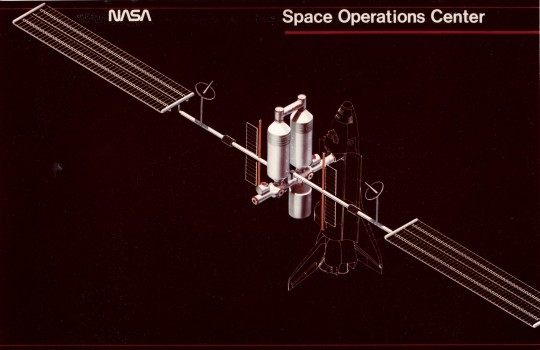

"The SOC is a self-contained orbital facility built up of several Shuttle-launched modules. With resupply, on-orbit refurbish- ment and orbit maintenance, it is capable of continuous operation for an indefinite period. In the nominal operational mode, the SOC is manned continuously, but unmanned operation is possible.
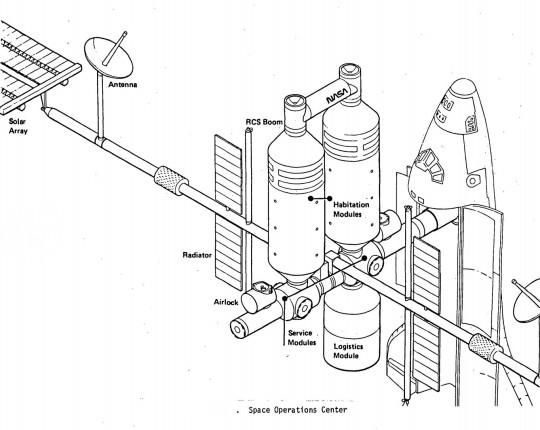
The present mission management and control process is characterized by a people-intensive ground monitoring and control operation involving large supporting ground information and control facilities and a highly- integrated ground-flight crew operation. In order to reduce dependence on Earth monitoring and control, the SOC would have to provide for increased systems monitoring; fault isolation and failure analysis, and the ability to store and call up extensive sets of data to support the onboard control of the vehicle; and the onboard capability for daily mission and other activity planning."
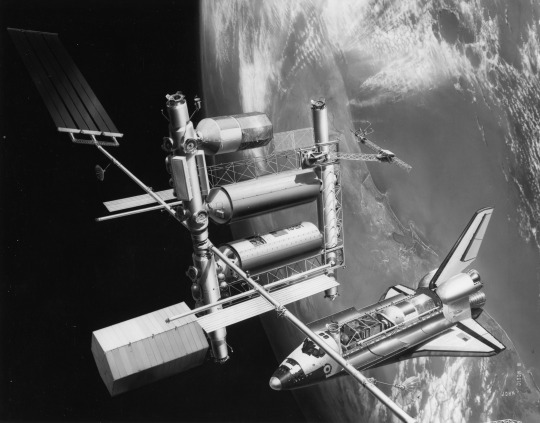
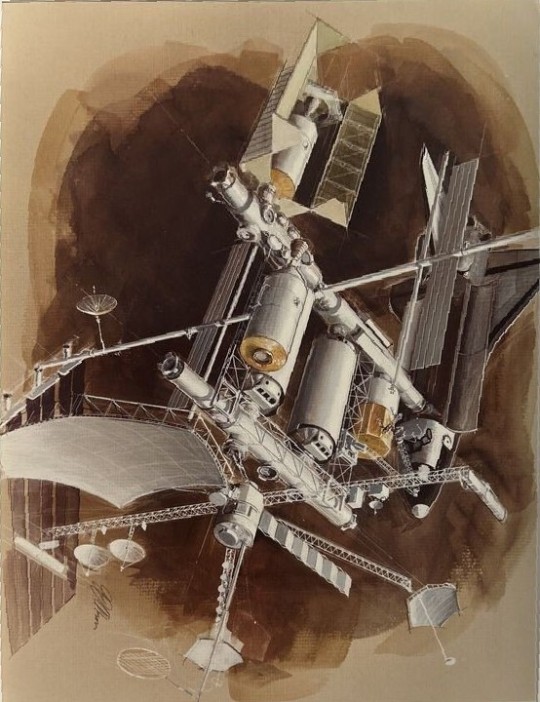

"Like most other space station studies from the mid/late 1970s its primary mission was the assembly and servicing of large spacecraft in Earth orbit -- not science. NASA/JSC signed a contract with Boeing in 1980 to further develop the design. Like most NASA space station plans, SOC would be assembled in orbit from modules launched on the Space Shuttle. The crew's tour of duty would have been 90 days. NASA originally estimated the total cost to be $2.7 billion, but the estimated cost had increased to $4.7 billion by 1981. SOC would have been operational by 1990.
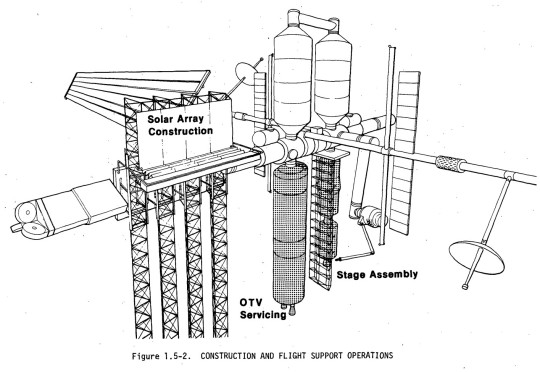
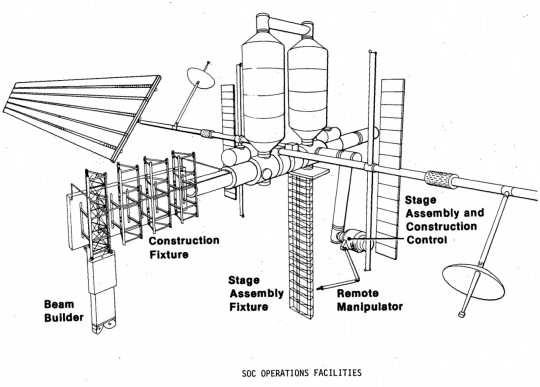

NASA's Johnson Spaceflight Center extended the Boeing contract in February 1982 to study a cheaper, modular, evolutionary approach to assembling the Space Operations Center. An initial power module would consist of solar arrays and radiators. The next launches would have delivered a space tug 'garage', two pressurized crew modules and a logistics module. The completed Space Operations Center also would have contained a satellite servicing and assembly facility and several laboratory modules. Even with this revised approach, however, the cost of the SOC program had grown to $9 billion. Another problem was Space Operations Center's primary mission: spacecraft assembly and servicing. The likely users (commercial satellite operators and telecommunications companies) were not really interested in the kind of large geostationary space platforms proposed by NASA. By 1983, the only enthusiastic users for NASA's space station plans were scientists working in the fields of microgravity research and life sciences. Their needs would dictate future space station design although NASA's 1984 station plans did incorporate a SOC-type spacecraft servicing facility as well."
Article by Marcus Lindroos, from astronautix.com: link

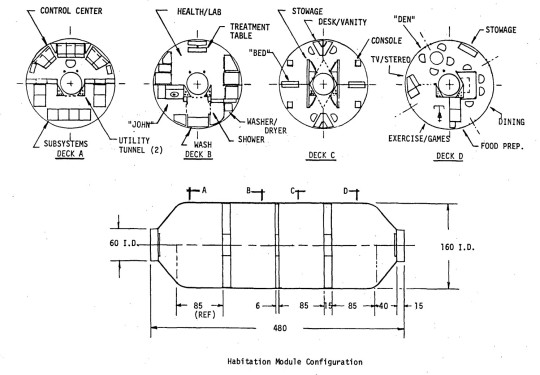


NASA ID: link, S79-10137
Boeing photo no. R-1859, link, link
#Space Operations Center#Space Station Freedom#Space Station Concept#Space Station#Concept Art#Space Station Program#Space#Earth#Space Shuttle#Orbiter#NASA#Space Shuttle Program#1979#1980s#my post
460 notes
·
View notes
Text

Welcome to The Simblr Office Directory
This blog is an archive of the submissions for the office-centric OC prompt posted by the light of Simblr, @kashisun.
Here you can browse all the amazing creations submitted by your fellow simblrs. Feel free to scroll to your delight or click one of the links under the cut to see who's on roster under (or over) a particular bureau or delegation.
Want to be added to the directory or confirm that you've been queued? Just include a link to your post in an ask off anon and it will be queued within 48 hours. Until we get through the backlog and can queue at a more leisurely pace, all ask submissions will receive a confirmation. You can always mention us, but we won't be able to provided confirmation for that method.
Leaving the company? If you'd like your post removed, just include a link to the post in an ask off anon and it will be removed. Sideblogs may require additional verification. Please allow, at most, 48 hours for the request to be honored. Removal requests will not be confirmed, only acted upon.
Every company's hierarchy is a little different. Designations for this directory are based on some of the companies I've worked for, but especially on the multi-media marketing company I work for now.
Bureaus and Their Delegations
Delegations with an * currently have low or no headcount (posted and queued). Excludes leadership.
Bureau of Client Engagement
Leadership
Billing*
Escalations*
Product Support*
Quality Assurance*
Sales*
Bureau of Compliance (Bureau-specific Internal Affairs and Auditing)
Leadership
Client Engagement*
Facilities*
Finance*
Human Resources*
Information and Technology*
Legal (General)
Legal (Leadership)
Marketing*
Bureau of Facilities
Leadership
Catering*
Environmental (Janitorial, HVAC, and Plumbing)*
Mechanical (Electrical, Elevators, Equipment Maintenance)*
Premise* (Grounds Maintenance and Real Estate)
Purchasing* (From pushpins to pallet jacks)
Security
Warehousing* (Shipping, Receiving, Mail room, and Inventory)
Bureau of Finance
Leadership
Accounting
Asset Management*
Investments*
Travel and Accommodations*
Vendor Relations*
Bureau of Human Resources
Leadership
Career Development (Internships and Internal Role Transitions)
Dependent Care*
Employee Activities Committee (Members are volunteers)
Employee Benefits*
Floating Delegates (Administration) (For profiles that list a nondescript secretary/admin/receptionist/assistant role)
Floating Delegates (General) (For profiles that do not list a position)
Floating Delegates (Leadership) (For profiles that list a nondescript managerial role)
Health Services*
Payroll*
Recruiting*
Training*
Union Relations*
Bureau of Information & Technology
Leadership
Data Security*
Infrastructure*
Public Relations
Research and Development*
Systems and Devices*
Telecommunications*
Bureau of Marketing
Leadership
Copy
Design
Planning and Implementation*
Board of Directors
Chief Officers
CEO - Chief Executive Officer/President
COO - Chief Operations Officer/Vice President
CCO - Chief Compliance Officer/Vice President
CFO - Chief Finance Officer/Vice President
CITO - Chief Information and Technology Officer/Vice President
CMO - Chief Marketing Officer/Vice President
Executive Administration* (Admins that report to chief officers)
206 notes
·
View notes
Text
Exploring the World of Electromechanical Systems: A Fusion of Electronics and Mechanics

Introduction:
In the realm of facility management, the effective operation and maintenance of electromechanical systems play a vital role in ensuring the smooth functioning of buildings and infrastructure. The fusion of electronics and mechanics has given rise to sophisticated systems that require skilled professionals to handle their operations and maintenance.
Electromechanical systems are a fascinating field that combines the principles of electronics and mechanics. These systems involve the integration of electrical components and mechanical structures to create devices capable of performing a wide range of tasks. From simple household appliances to complex industrial machinery, electromechanical systems are an integral part of our daily lives.
Understanding Electromechanical Systems:
Electromechanical systems are integral to the functioning of modern facilities. These systems combine electrical and mechanical components, utilizing electronic controls to enhance efficiency and automation. Examples include HVAC (Heating, Ventilation, and Air Conditioning) systems, elevators, escalators, fire protection systems, security systems, and energy management systems.
Workforce Requirements:
To ensure the optimal performance of electromechanical systems, facility management teams require a diverse range of professionals with specialized skill sets. Key roles may include:
a. Engineers: Electrical and mechanical engineers are crucial for system design, installation, and troubleshooting. They possess the technical knowledge to handle complex electromechanical systems.
b. Technicians: Skilled technicians play a vital role in maintaining, inspecting, and repairing electromechanical systems. They are responsible for regular maintenance, diagnosing issues, and performing necessary repairs or replacements.
c. Operators: Operators are responsible for monitoring and controlling electromechanical systems, ensuring their proper functioning and responding to alarms or emergencies.
d. Facility Managers: These professionals oversee the operations and maintenance of electromechanical systems, ensuring compliance with regulations, managing budgets, and coordinating the work of the entire facility management team.
Recruitment Strategies:
To build a competent team for operations and maintenance in facility management, consider the following recruitment strategies:
a. Job Portals: Utilize online job portals that cater to the facility management industry to reach potential candidates with the desired skill sets.
b. Industry Networks: Engage with industry-specific networks, associations, and professional forums to connect with qualified professionals in the field of electromechanical systems.
c. Collaboration with Technical Institutes: Partner with technical institutes and vocational schools to tap into fresh talent. Establish internship programs or participate in job fairs to attract entry-level candidates.
d. Skill Assessment: Conduct thorough skill assessments during the recruitment process to evaluate candidates' proficiency in handling electromechanical systems and their related components.
Training and Professional Development:
Given the complexity and evolving nature of electromechanical systems, investing in training and professional development is crucial. Provide regular training sessions to enhance the skills of your workforce, keeping them up-to-date with the latest technologies and maintenance practices. Encourage employees to attend industry conferences, workshops, and certifications to expand their knowledge base.
Safety and Compliance:
Operations and Maintenance in Facility Management must prioritize safety and compliance. Ensure that all staff members are well-versed in safety protocols, including electrical safety, lockout/tagout procedures, and handling hazardous materials. Familiarize your team with relevant regulations and standards, such as building codes, fire safety regulations, and environmental guidelines.
Team Collaboration and Communication:
Effective collaboration and communication within the facility management team are vital for seamless operations and maintenance. Foster a culture of teamwork, encourage knowledge sharing, and promote open lines of communication between different departments and roles. This collaborative approach can lead to efficient problem-solving and improved system performance.
Conclusion:
Electromechanical systems form the backbone of facility management, and staffing considerations for operations and maintenance are crucial to ensure their reliable and efficient functioning. By understanding the workforce requirements, implementing effective recruitment strategies, prioritizing training and professional development.
#Water Treatment Plant Manufacturers in India#Sewage Treatment Plant Manufacturers in India#Operation and Maintenance of Water Treatment#Operations and Maintenance in Facility Management#Water Treatment Plant Project#Sewage Treatment Plant Project#Effluent Treatment#Best Electromechanical Systems#Integrated Electronics and Mechanics
2 notes
·
View notes
Text
more stark tower info: employees/staff
aight y'all know the drill, long post read below take w a grain of salt use in your own stuff if you want just pls credit!!!
Stark Industries Corporate Offices
Standard offices for legal, HR, finance, PR, business development.
100–150 employees per floor.
Estimated Employees: ~3,000–3,500
Research & Development, AI, & Cybernetics
Labs for AI development, cybernetics, energy research, and defense tech.
50–80 scientists/engineers per floor.
Estimated Employees: ~600–900
Secure Weapons & Suit R&D, Advanced Tech Labs
Classified research with fewer but highly specialized staff.
40–60 engineers per floor.
Estimated Employees: ~400–600
Security Personnel
On rotation across lobby, underground, R&D areas, and executive floors.
1,000+ security staff total, but ~300-400 on-site at a time.
Estimated On-Site Security Staff: ~300-400
Industrial Storage, Robotics, Engineering Workshops
Large-scale robotics & AI facilities.
50–100 engineers per level.
Estimated Employees: ~800–1,200
Additional Support Staff Breakdown
Food Services (Restaurants, Café, Lounge)
In-house restaurant & café: Serves thousands daily.
Chefs, baristas, waitstaff, managers.
Estimated Employees: ~250-300
Housekeeping & Cleaning Crew
Cleaning for 73 floors + underground.
Day & night shift crews rotating.
Estimated Employees: ~400-500
Maintenance & IT Support
Building engineers, electricians, IT, and HVAC technicians.
Estimated Employees: ~300-400
Personal Assistants & Admin Staff
High-level executive assistants, receptionists, and schedulers.
Estimated Employees: ~150-200
Interns & Entry-Level Workers
STEM interns, business interns, and apprentices.
Estimated Employees: ~200-300
TOTAL: 6,400–7,800 Employees
Daily on-site occupancy likely 5,000–6,000 people at peak hours.
Events, high-security operations, or crises could temporarily raise staffing needs.
other info
contract tour guides also give regular tours of the publicly accessible parts of Stark Tower
tours are available to the public, and for schools/private organizations
tour guides are contract workers for a tourism company that work with Stark Tower and tons of other places in Manhattan
security levels
still working on security clearance levels lol but keep in mind that all departments have a hierarchy of clearance
like within housekeeping the more entry level positions work in the public parts of the tower, and the higher ranking/more trusted employees work in the more secure areas
this does extend all the way to Tony's penthouse and the Avengers areas
staff in these high security areas have to go through a lot of measures (NDAs, fingerprinting, getting their DNA on file etc) and are also monitored constantly
which might sound overkill until you think about how many times people have tried to kill Tony. also there are literal government secrets up in that bitch. so yeah. good pay good job security as long as you don't fuck around where you're not supposed to
realistically Tony probably will also have cleaning drones for some more dangerous or ultra secure areas. The people who do maintenance on those robots are also under heavy security protocols to make sure they don't sabotage anything
visuals for the rooms and floors coming soon!!
DISCLAIMER: the lists of employees and their numbers were partially generated with chatgpt, everything else (other info and security levels) was organically written by me without the use of ai
#op's world building (we're just living in it)#stark tower#tony stark#mcu#marvel cinematic universe#avengers#avengers headcanons#mcu headcanons#marvel headcanons#also PHAT shout out to chatgpt because I cannot do math#thank you for essentially being my robot therapist and ironing out all the wrinkly scrungkly little thoughts I push into your doggy door#chatgpt my beloved <3#tw ai
11 notes
·
View notes
Text
Standard Chastity/Underwear/Diaper Component of the Armor Suit
The Standard Chastity/Underwear/Diaper Component is an integral part of the advanced full-body armor suit worn by Cadets, Conscripts, Reservists and Intendurds in the Security Forces, Lifeguards, Paramedic Corps and Nursing Corps and training academies. This component is designed to ensure hygiene, control, and comfort for the wearer, whether used in conjunction with the full armor suit or as a standalone piece of equipment.

Design and Features
Material: Constructed from high-density, hypoallergenic synthetic fabrics, the component provides durability, flexibility, and breathability. The inner lining is coated with an antimicrobial layer to prevent infections and maintain cleanliness over extended periods.
Two-Chamber Design: The component features a specialized two-chamber design. One chamber securely encases the penis, while the other accommodates the scrotum, ensuring both are protected and kept in an optimal environment. This design helps in preventing chafing and maintaining hygiene, even during extended periods of use.
Chastity Mechanism: The chastity feature includes a secure, ergonomic cage designed to prevent unauthorized sexual activity. Made from lightweight, medical-grade polymers, it ensures comfort while maintaining strict control. The cage can be adjusted to fit various sizes and shapes, ensuring a snug but non-restrictive fit.
Waste Management: Integrated into the design is an advanced waste management system. This includes absorbent layers capable of handling urine and fecal matter, which are quickly wicked away to prevent discomfort and skin irritation. The component can be easily cleaned and sanitized, whether worn as part of the armor or independently.
Compatibility: The component seamlessly integrates with the full-body armor suit. Connection points allow for the automated removal and disposal of waste, managed by the suit’s internal systems. When worn independently, it functions efficiently, ensuring the wearer remains hygienic and comfortable.
Security and Monitoring: Equipped with biometric sensors, the component monitors the wearer’s physiological state, transmitting data to the suit’s central processing unit or an external monitoring system. This includes tracking hydration levels, waste excretion, arousal and other vital signs to ensure optimal health and performance.
Comfort and Fit: Designed for extended wear, the component features adjustable straps and a contoured design to prevent chafing and discomfort. The fit can be customized to each wearer, ensuring it remains secure without impeding movement or flexibility.

Usage and Maintenance
Usage: The Standard Chastity/Underwear/Diaper Component is designed for continuous use up to 7 days, with a standard operational period of 5 days. This duration ensures that cadets remain in peak condition during extended training exercises or deployments, without the need for frequent removal or maintenance.
Maintenance: Regular cleaning and sanitization are required to maintain its functionality and hygiene standards. The component can be detached from the suit and cleaned using standard military-grade cleaning agents. Replacement parts and servicing are available through authorized personnel and facilities.
The Standard Chastity/Underwear/Diaper Component exemplifies the blend of technological innovation and practical application, ensuring cadets maintain hygiene and comfort during their rigorous training and operational duties.

22 notes
·
View notes
Text
Cost vs. Quality: What to Consider When Investing in Switchgear

In today’s energy-intensive world, switchgear plays a critical role in managing power distribution safely and efficiently. Whether you’re upgrading your industrial facility, building a commercial plant, or powering a large infrastructure project, choosing the right switchgear is not just a technical decision — it’s a strategic investment. One of the most common dilemmas buyers face is balancing cost vs. quality. So, how do you decide?
Understanding Switchgear: The Heart of Electrical Safety
Switchgear is a combination of electrical disconnect switches, fuses, or circuit breakers used to control, protect, and isolate electrical equipment. Its primary role is to ensure the reliability and safety of your power system.
Types of switchgear include:
· Low-voltage switchgear (for commercial and residential use)
· Medium-voltage switchgear (typically for industrial applications)
· High-voltage switchgear (used in power transmission)
Investing in the right switchgear directly impacts operational continuity, personnel safety, and overall infrastructure reliability.
The True Cost of Cheap Switchgear:
While it’s tempting to opt for budget-friendly solutions, low-cost switchgear often comes with hidden risks and long-term expenses.
Inferior Material Quality
Cheaper models often use substandard materials that degrade faster, leading to frequent maintenance or early replacement.
Safety Hazards
Low-quality switchgear can result in arc faults, insulation failure, or overheating — putting workers and equipment at risk.
Increased Lifecycle Costs
Although the initial price may be low, the total cost of ownership (including downtime, repair, and energy inefficiency) is usually higher.
Limited Scalability and Customization
Budget systems are often rigid and harder to scale as your facility grows or needs change.
Why Quality Switchgear Pays Off
When you invest in premium switchgear, you’re not just buying a product — you’re buying peace of mind.
Enhanced Reliability
High-quality switchgear is engineered to perform in extreme conditions and handle high fault levels without compromising performance.
Superior Safety Standards
Reputable brands comply with international standards such as IEC, ANSI, or UL, reducing liability and improving workplace safety.
Ease of Maintenance
Well-built switchgear is modular and user-friendly, simplifying diagnostics and minimizing downtime during maintenance.
Energy Efficiency & Smart Capabilities
Modern switchgear includes IoT sensors, real-time monitoring, and predictive maintenance features, ensuring optimal energy use and proactive problem resolution.
Key Factors to Consider When Choosing Switchgear
When evaluating switchgear options, balance cost and quality by focusing on the following:
1. Application Requirements
Understand your voltage class, load types, and fault current ratings. Quality should match your operational demands.
2. Brand Reputation & Certification
Look for trusted brands with certifications like ISO 9001, CE, or IEC 62271. Positive reviews and case studies add credibility.
3. Lifecycle Costs
Don’t just compare sticker prices — consider maintenance, service availability, spare part costs, and expected lifespan.
4. Customization & Flexibility
Choose systems that can evolve with your operation. Modular designs support upgrades and expansions more efficiently.
5. Support and Service
Ensure the manufacturer provides robust after-sales support, technical training, and warranty services.
Cost vs. Quality: The Bottom Line
When it comes to switchgear, cheap is rarely cheerful. Cutting corners today can lead to outages, hazards, and hefty repair bills tomorrow. On the other hand, investing in high-quality switchgear ensures operational resilience, safety, and long-term savings.
The smartest strategy? Aim for value, not just price. Evaluate switchgear as a long-term asset, not just a one-time purchase.
Trending Tip: Think Smart and Sustainable
With rising energy demands and climate-conscious regulations, smart and sustainable switchgear is trending. Look for:
· Eco-friendly insulation (like SF₆-free switchgear)
· Energy management features
· Digital monitoring systems
Investing in such features not only future-proofs your infrastructure but can also help you qualify for green certifications and incentives.
Final Thoughts
Balancing cost and quality in switchgear selection is about understanding your long-term operational goals. By focusing on durability, safety, and lifecycle value, you can make a decision that protects both your budget and your business.
8 notes
·
View notes
Text
Switchgear Solutions for Solar and Wind Energy Systems

Why Switchgear Matters in Solar and Wind Systems
Switchgear plays a central role in controlling, isolating, and protecting electrical equipment. In renewable energy applications, it helps:
· Manage power flow from variable energy sources.
· Protect systems from faults or overloads.
· Ensure seamless grid integration and disconnection when needed.
Unlike traditional power plants, solar and wind systems generate intermittent power, requiring switchgear that can handle dynamic loads and frequent switching.
Challenges in Renewable Energy Applications
Here are some of the unique challenges renewable energy systems face — and how they impact switchgear selection:
1. Variable Output
Solar and wind energy production fluctuates based on weather and time of day. This demands switchgear that can:
· Handle frequent load changes.
· Operate reliably under fluctuating voltages and currents.
2. Decentralized Generation
Unlike centralized grids, solar and wind systems are often spread out across multiple locations.
· Modular, compact switchgear is preferred for such installations.
· Smart monitoring becomes critical to manage performance remotely.
3. Harsh Environments
Wind turbines operate at high altitudes, and solar farms are often exposed to heat, dust, or salt.
· Switchgear needs to be rugged, weather-resistant, and have high IP ratings.
· Outdoor switchgear enclosures and temperature management are essential.
Key Features of Switchgear for Solar & Wind
When designing or upgrading renewable energy systems, look for switchgear that offers:
1. Remote Monitoring and Control
Smart switchgear integrated with IoT technology allows operators to track real-time data, detect faults early, and optimize system performance.
2. High Interruption Capacity
Wind and solar systems may experience voltage spikes. Modern switchgear provides high breaking capacities to safely interrupt fault currents.
3. Modular Design
Allows for easy upgrades and maintenance — crucial for scaling renewable installations.
4. Eco-Friendly Design
Look for SF₆-free switchgear that uses clean air or other sustainable alternatives to reduce environmental impact.
5. Hybrid Capabilities
Switchgear that can connect both AC and DC sources is increasingly valuable in mixed-source grids.
LV, MV, and HV Switchgear for Renewables
· Low Voltage (LV) Switchgear: Used in residential or small-scale solar systems. Compact, safe, and cost-effective.
· Medium Voltage (MV) Switchgear: Ideal for commercial and industrial solar/wind applications.
· High Voltage (HV) Switchgear: Essential for utility-scale wind farms or solar plants feeding into the national grid.
Each type requires specific protection, metering, and automation components tailored to its load and system requirements.
Final Thoughts
Switchgear is the backbone of any successful solar or wind energy system. As these technologies become more mainstream, the demand for resilient, intelligent, and environmentally friendly switchgear solutions will continue to rise.
Whether you’re an energy consultant, project developer, or facility manager, choosing the right switchgear today will set the stage for long-term efficiency, safety, and scalability.
8 notes
·
View notes
Text
Istanbul Mayor Ekrem Imamoglu made headlines in April after coasting to a second term in office by nearly 12 percentage points. Imamoglu, who has served at the city’s helm since 2019, is seen as a major political threat to Turkish President Recep Tayyip Erdogan and his Justice and Development Party (AKP). The latest win in Istanbul cemented Imamoglu’s continued popularity among the Turkish public.
But Imamoglu is only the most prominent face of a broader opposition, led by the Republican People’s Party (CHP). In March’s municipal elections, the CHP secured its most crushing victory over the AKP in decades. Possibly more notable than Imamoglu’s reelection was the newly elected class of women executives of provinces and districts across the country.
One of these women—Sinem Dedetas—may hold the keys to the future of Turkey’s opposition. Imamoglu is currently battling slander charges in the country’s high court, in addition to a slew of other cases that could eventually ban him from politics, even as he is the favorite to run for the CHP in Turkey’s 2028 presidential election. No matter how those fortunes play out, Dedetas promises to be central to the party’s strategy in a post-Erdogan Turkey.
Istanbul is the only city in the world to straddle two continents. Uskudar, a seaside constituency on the Anatolian side, lacks many of the bars and clubs across the water in the European districts. Instead, the conservative area is known for its historical mosques. It is also one of Istanbul’s key transportation hubs, home to a confluence of ferries, rail, metro, and bus lines. Millions of people from all over the city—and world—pass through Uskudar every day.
In April’s elections, Dedetas, a 43-year-old engineer, made history as the first woman to ever win the Uskudar municipality mayorship, a position similar to that of a New York borough president. She also flipped the district from the AKP to CHP rule.
Dedetas moved to Uskudar from her native Eskisehir, a city in northwest Turkey, for college in 1999. After receiving bachelor’s and master’s degrees in naval engineering from Istanbul Technical University, she got her first job in the district as an engineer. In 2014, she went on to work as a marine engineer at the Halic Shipyards, the oldest continuously operating dockyard in the world. Over the centuries, the facility has produced vessels from sail boats to steamships and submarines to electrical passenger taxis.
Dedetas’s career has featured many firsts. In 2014, she became the first chairwoman of the Turkish Chamber of Naval Engineers. While she was in that position, Istanbul’s AKP mayor tried to privatize the public harbor and turn it into a terminal full of restaurants and shops. Dedetas protested the project and was barred by the government from entering the shipyard.
She continued to oppose the new real estate development, concerned that the city’s ferries—an indelible part of Istanbul’s social history, skyline, and soundscape—would grind to a halt without the vital maintenance work done at the docks. “We fought to keep [it] from being lost,” Dedetas later said after her success in blocking the project.
Then Imamoglu became mayor of the city, bringing Istanbul back under CHP rule. “The privatization processes of the shipyard were being carried out,” Dedetas told Turkish media. “If [the mayorship] had not changed hands in the 2019 elections, there would be no shipyard left.”
One of the new mayor’s first orders of business was to appoint Dedetas as manager of Istanbul’s maritime public transportation system; she was the first woman in the role. Over the last quarter century, the city’s water transport fell into disarray as Istanbul’s population swelled and moved further inland, contributing to congestion and gridlock on road and rail. Yet municipal-run ferries predate the first Bosporus bridge and remain one of the city’s fastest options to cross continents.
Dedetas proved herself to be a masterful administrator, overhauling the entire water transit system. She opened 11 new ferry lines and launched a 24-hour weekend ferry that connected the European and Asian sides of the city. She also doubled the patronage of public water transport, in part by restoring the iconic white and orange vapur ferry ships. And she launched an electric sea taxi service, providing a personal, environmentally friendly option to traverse the Bosporus Strait and the Marmara Sea.
Through the effective management of maritime transportation, Dedetas gained national attention. She set her eyes on her home district, Uskudar—the Istanbul neighborhood with the longest Bosporus shoreline—ahead of the 2024 municipal elections. “Uskudar is the first gate for people who arrive from Anatolia, and for Istanbul, it is the gate to the rest of the country,” said Onur Cingil, an Uskudar native and CHP member.
The borough had been an AKP stronghold for as long as Cingil and most others could remember. It is even home to Erdogan’s private villa. Cingil said he saw local government officials claim eminent domain and exaggerate concerns about earthquake vulnerability to demolish buildings and hand over lucrative sites to construction companies, religious associations, and other party loyalists. “This happened … to my own student dormitory, and many other places,” Cingil said.
Cingil was one of the many CHP candidates vying to be the nominee for Uskudar’s mayorship in March’s elections, but the CHP leadership eventually selected Dedetas to run due to her reputation for being a technocratic consensus builder.
“Normally, I wouldn’t expect such a profile to be nominated for Uskudar,” said Burak Bilgehan Ozpek, a professor of political science at TOBB University of Economics and Technology. He described Dedetas’s young, professional, and secular profile as going against the grain in the district. The CHP typically nominated old-school, male party insiders for such roles, Ozpek said, adding with a laugh that they always lost the race. “This was a radical change,” he added.
Dedetas took a pro-people approach to her campaign against the AKP incumbent Hilmi Turkmen, who had been a mainstay in Uskudar’s politics for decades. She canvassed the district neighborhood by neighborhood, underlining her accomplishments governing the city’s maritime transit system, which has a budget the same size as Uskudar’s.
Dedetas vowed to redress the AKP’s neglect of women’s issues on both the district and federal levels. She promised to prioritize women’s employment and noted that, during her time helming Istanbul’s maritime transit system, she nearly tripled the number of women working there. She also proposed the creation of a free HPV vaccine program to protect against some forms of cervical cancer. (The cost of the vaccine has become nearly equivalent to Turkey’s monthly minimum wage.)
The candidate pledged to create child nurseries in every neighborhood in Uskudar. “This will enable women to work,” especially residents with low incomes, said Rumeysa Camdereli, an activist and member of Havle Women’s Association, the first Muslim feminist organization in Turkey.
Dedetas promised to expand welfare initiatives, and called for additional municipally subsidized cafeterias in Uskudar. Imamoglu created these during his first term for residents to get a healthy meal for just over a dollar, and his AKP competitor Murat Kurum mocked them on the campaign trail. “We are tired and bored of the rhetoric that tries to deceive the people by … giving half a tea glass of water or milk as if it is a service,” said Kurum. He also made fun of Imamoglu’s background as a kofte vendor.
Kurum’s gaffe turned off blue collar voters. Istanbul’s public eateries fill up every day for lunch and are vital in a country enduring a cost-of-living crisis amid annual inflation of nearly 70 percent.
“Local elections are less ideological and always more focused on services,” said Emine Ucak, the program director for social policy at the Reform Institute, an Istanbul-based policy center, who researches women in Turkish politics. “Women always think about their children, and they had stopped seeing a future for them.”
The campaign also focused on securing areas most vulnerable to earthquakes, a national concern after the devastating February 2023 earthquakes in Turkey’s southeast. Many locals fear that the slate block flats populating the hills above Uskudar’s wharf are in imminent danger in case of an earthquake. In response to their concerns, Dedetas is establishing a natural disaster directorate to help the district become prepared for earthquakes and other catastrophes.
On election night, Dedetas triumphed, beating Turkmen by more than seven percentage points. In doing so, she tore apart the long-held myth that Uskudar was an AKP stronghold.
“It’s a district with a lot of conservative families,” said Asli Aydintasbas, a visiting fellow at Brookings Institution. “For an uncovered woman to win is a real testament to her political appeal.” Unlike past CHP candidates, Dedetas shied away from the hardline, sometimes alienating secularism her party is known for. Pragmatism and empathy won the day.
Dedetas was not the only victorious woman on election day. Altogether, voters tripled the number of women mayors across Turkey. While only four female mayors had been elected in the previous municipal elections in 2019, 11 provinces and 64 municipalities are now governed by women, the vast majority of them representing opposition parties. Together, they won, on average, 53 percent of votes.
Female political representation is a welcome change after what many in the country see as backsliding on women’s rights under Erdogan. In 2021, Turkey exited the Istanbul Convention, an international treaty to combat gender-based violence that was drafted in the city a decade earlier. The Turkish president had urged women to have at least three children, claiming that those who reject motherhood are “deficient” and “incomplete.”
Although Turkey has a highly centralized political system, mayors remain key to managing districts and municipalities. They are where citizens first access the country’s welfare systems, and where businesses are registered, among other duties.
Following March’s elections, Dedetas and other mayors in the Turkish opposition now have their best chance in decades to govern with less interference from Ankara. She has wasted no time in initiating programs that address locals’ needs, such as grocery subsidies of up to $150 for retired residents. The district also plans to provide elderly residents free shuttle services to food markets. (Pensioners, who compose more than 10 percent of Turkey’s national population, receive roughly $293 per month from the state, an impossible wage to live on in Istanbul.)
Uskudar’s new mayor is also working to counteract the AKP’s neoliberal strategies, which many accuse of benefiting political patrons through shady backroom dealings all while poverty has deepened. To help promote transparency, Dedetas has begun to broadcast all municipal council meetings live online.
Figen Kucuksezer, an optometrist and Uskudar resident, is very excited by these changes. They’ve already helped preserve Uskudar’s Validebag Grove, one of the last wild green spaces in Istanbul. The area, which Kucuksezer volunteers to protect, is home to 400-year-old trees and migratory birds.
“The former mayor always wanted to make changes to the grove,” she said, referring to the AKP’s plans to develop the area by adding parking lots and food stalls and removing some native flora. But Kucuksezer and other local activists filed a lawsuit and have fought for years for Validebag to be left alone. “We had to block the Caterpillar [equipment] from entering in,” she said.
Since being elected, Dedetas has promised to protect it as a green space for all residents. In May, the local court annulled the previous government’s construction plan. “It is a breath of fresh air,” Kucuksezer added.
There is a saying in Turkish politics that whoever wins Istanbul will one day win Turkey. It was the case for Erdogan, who previously served as mayor of Istanbul before leading the country for the past two decades.
After years in the political wilderness, the CHP is now trying to repeat its success in the next national election, which should be the first without Erdogan in nearly 30 years. The challenge for Dedetas is to help Imamoglu triumph so that she can be his successor in Istanbul as he runs for the presidency.
So far, her stances have mirrored those of Imamoglu; Dedetas regularly highlights their work together on social media. But she has also bolstered her own profile by engaging in key culture war debates—including by opposing controversial legislation that will kill beloved stray dogs on the streets to rooting for the women’s national volleyball team at the Paris 2024 Olympics, a squad that has been vilified by the conservative right. Imamoglu’s and Dedetas’s fortunes are now intertwined.
“And this is just the start of her office,” said Cingil, Dedetas’s one-time party rival. “There are already rumors that she will be the next candidate for Istanbul mayor.” That would be another first.
15 notes
·
View notes